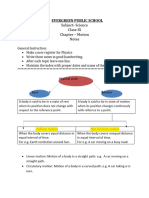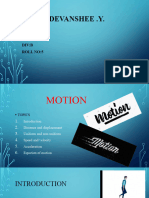0% found this document useful (0 votes)
33 views2 pagesClass 9 Physics Motion Quick Notes
The document provides an overview of motion in physics, defining it as the change in position over time and categorizing it into uniform and non-uniform motion. Key terms such as distance, displacement, speed, velocity, and acceleration are explained, along with important formulas and graphical representations. It also covers types of acceleration and uniform circular motion, emphasizing the distinction between scalar and vector quantities.
Uploaded by
jeelmachhi4Copyright
© © All Rights Reserved
We take content rights seriously. If you suspect this is your content, claim it here.
Available Formats
Download as PDF, TXT or read online on Scribd
0% found this document useful (0 votes)
33 views2 pagesClass 9 Physics Motion Quick Notes
The document provides an overview of motion in physics, defining it as the change in position over time and categorizing it into uniform and non-uniform motion. Key terms such as distance, displacement, speed, velocity, and acceleration are explained, along with important formulas and graphical representations. It also covers types of acceleration and uniform circular motion, emphasizing the distinction between scalar and vector quantities.
Uploaded by
jeelmachhi4Copyright
© © All Rights Reserved
We take content rights seriously. If you suspect this is your content, claim it here.
Available Formats
Download as PDF, TXT or read online on Scribd
/ 2
























































